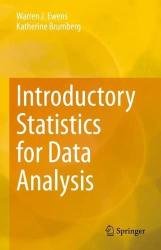Introductory Statistics for Data Analysis
- Добавил: literator
- Дата: 15-05-2023, 04:51
- Комментариев: 0
 Название: Introductory Statistics for Data Analysis
Название: Introductory Statistics for Data AnalysisАвтор: Warren J. Ewens, Katherine Brumberg
Издательство: Springer
Год: 2023
Страниц: 272
Язык: английский
Формат: pdf (true), epub
Размер: 10.6 MB
This book describes the probability theory associated with frequently used statistical procedures and the relation between probability theory and statistical inference. The first third of the book is dedicated to probability theory including topics relating to events, random variables, and the Central Limit Theorem. Statistical topics then include parameter estimation with confidence intervals, hypothesis testing, chi-square tests, t tests, and several non-parametric tests. Flow charts are frequently used to facilitate an understanding of the material considered. The examples and problems in the book all concern simple data sets which can be analyzed with a simple calculator; however, the R code required to complete many examples and problems is provided as well for those that are interested.
The word “Statistics” means different things to different people. For a baseball fan, it might relate to batting averages. For an actuary, it might relate to life tables. In this book, we mean the scientific definition of “Statistics”, which is Statistics is the science of analyzing data in whose generation chance has played some part. This sentence is the most important one in the entire book, and it permeates the entire book. Statistics as we understand it via this definition has become a central area of modern science and data analysis, as discussed below.
Why is Statistics now central to modern science and data analysis? This question is best answered by considering the historical context. In the past, Mathematics developed largely in association with areas of science in which chance mechanisms were either non-existent or not important. Thus in the past a great deal of progress was made in such areas as Physics, Engineering, Astronomy and Chemistry using mathematical methods which did not allow any chance, or random, features in the analysis. For example, no randomness is involved in Newton’s laws or in the theory of relativity, both of which are entirely deterministic. It is true that quantum theory is the prevailing paradigm in the physical sciences and that this theory intrinsically involves randomness. However, that intrinsic level of randomness is not discussed in this book.
Contents:
Скачать Introductory Statistics for Data Analysis
Внимание
Уважаемый посетитель, Вы зашли на сайт как незарегистрированный пользователь.
Мы рекомендуем Вам зарегистрироваться либо войти на сайт под своим именем.
Уважаемый посетитель, Вы зашли на сайт как незарегистрированный пользователь.
Мы рекомендуем Вам зарегистрироваться либо войти на сайт под своим именем.
Информация
Посетители, находящиеся в группе Гости, не могут оставлять комментарии к данной публикации.
Посетители, находящиеся в группе Гости, не могут оставлять комментарии к данной публикации.

